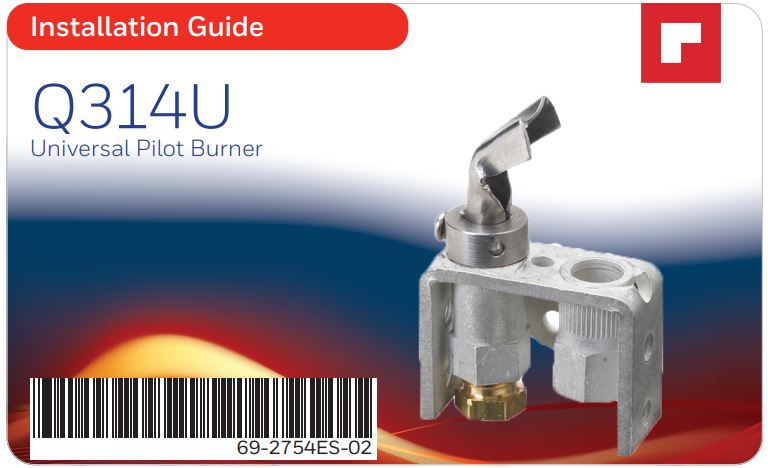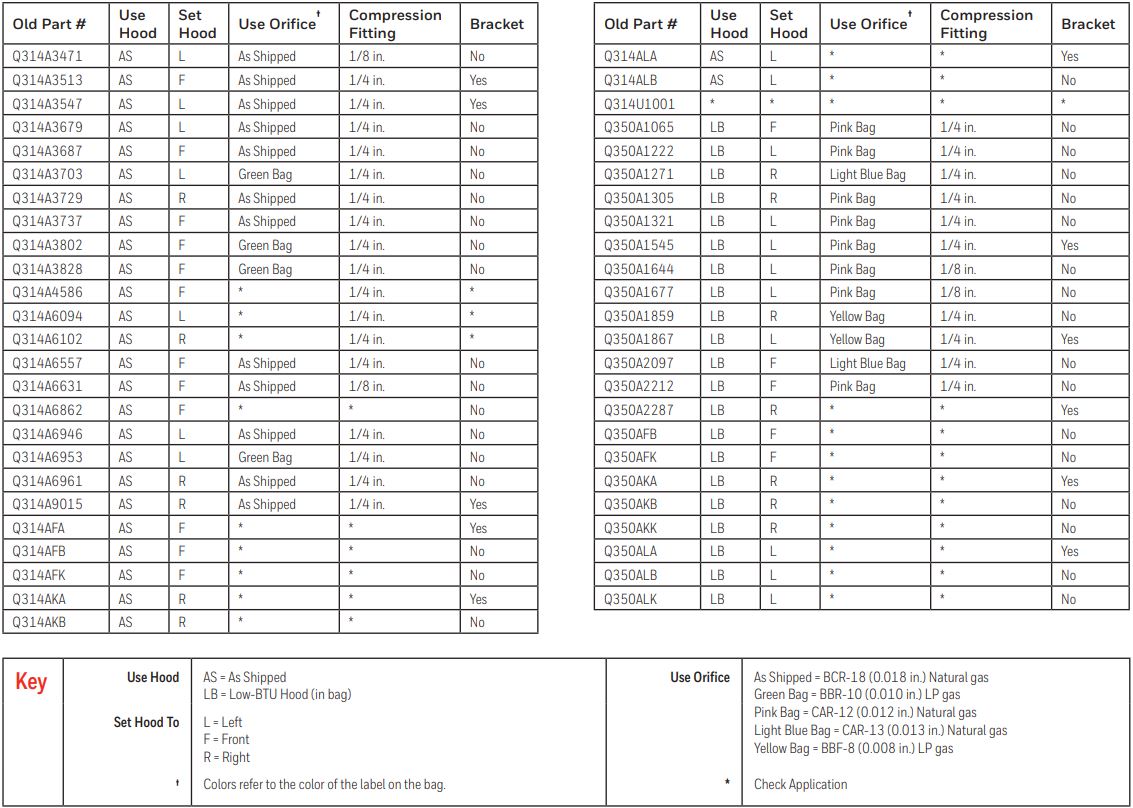Honeywell Q314U Universal Pilot Burner Installation Guide
Honeywell Q314U Universal Pilot Burner Installation Guide

Cross Reference (Use only as a replacement for these Resideo pilots)

Note
This pilot replaces only Resideo standard hood-style standing pilot burners.
It will not replace batwing style pilot burners or intermittent pilot burners.
- For standard hood-style intermittent pilot burners see the Q345U or the Q3451U.
- For batwing-style intermittent pilot burners see the Q348U.
The specifications given here do not include normal manufacturing tolerances. Therefore, this unit may not exactly match the listed specifications.
This product is tested and calibrated under closely controlled conditions, and some minor differences in performance should be expected if those conditions are changed.
WHEN INSTALLING THIS PRODUCT…
- Read these instructions carefully. Failure to follow instructions can damage equipment or cause a hazardous condition.
- Check cross reference in the installation guide or box to verify the pilot is suitable for your application.
- Installer must be a trained, experienced service technician.
- After completing installation, use these instructions to check out product operation.
FIRE OR EXPLOSION HAZARD. CAN CAUSE PROPERTY DAMAGE, SEVERE INJURY, OR DEATH.
Follow these warnings exactly:
- Disconnect power supply before wiring to prevent electrical shock or equipment damage.
- To avoid dangerous accumulation of fuel gas, turn off gas supply at appliance service valve before starting installation and perform Gas Leak Test after completion of installation.
- Do not bend pilot tubing within 3 inches of the gas control or pilot burner after compression nut has been tightened. Gas leakage at the connection can result. Follow the appliance manufacturer instructions, if available; otherwise, use the instructions provided.
1 Remove the Old Pilot Burner
- A Make sure gas is shut off.
- B Remove old Pilot Burner, including the old compression fitting.
- C Match the old model number to the Cross Reference.
- D Use the information in the Cross Reference to install the Pilot Burner.
2 Set the Hood
See Cross Reference for position and hood selection.
NOTE: Choose between standard (installed) or Low BTU
FIRE OR EXPLOSION HAZARD. CAN CAUSE PROPERTY DAMAGE, SEVERE INJURY, OR DEATH.
Pilot flame must be positioned in the exact same position with respect to the main burner. The screw must be installed through the pilot hood and into the spud, so the head of the screw is flush with the adapter. Failure to properly orient the pilot flame and/ or secure the pilot hood may create an explosion hazard.
3 Mount Pilot Burner
Use the included screws to mount the Pilot Burner. Use the Auxiliary Mounting Bracket if needed.
Position the Pilot Burner so the pilot flame is aimed at the main burner exactly the same way as the original pilot burner flame.
FIRE OR EXPLOSION HAZARD. CAN CAUSE PROPERTY DAMAGE, SEVERE INJURY, OR DEATH.
Pilot burner flame alignment to the main burner is critical to safe appliance operation. Carefully read all installation instructions. Replace only those pilots listed in the literature.
4 Install the Correct Orifice and Compression Fitting
See Cross Reference for orifice and sizes.
NOTE: The Low BTU Hood must be used with one of the orifices packed with it. The standard BTU Hood can only be used with the BBR-10 orifice (Green bag) or the BCR-18 orifice that was initially
Cut off the old compression fitting and replace with the new compression fitting provided with the new pilot burner. Never use the old compression fitting because it might not provide a gas-tight seal.
FIRE OR EXPLOSION HAZARD. CAN CAUSE PROPERTY DAMAGE, SEVERE INJURY, OR DEATH.
Orifice must be the same size as the original orifice.
5 Install the Thermocouple or Thermopile
See Cross Reference for position and size.
6 Gas Leak Test and Checkout
Gas Leak Test
- A Make sure warning card has been removed from the pilot.
- B Turn on gas supply.
- C Use a gas sniffer* or paint the pipe connections upstream of the pilot burner with a rich soap and water solution to check for leaks. Bubbles indicate a gas leak.
- D If a leak is detected, tighten the pipe connections.
- E Stand clear of the main burner while lighting to prevent injury from hidden leaks, which can cause flashback in the appliance vestibule.
- F Set the thermostat to call for heat to light the main burner.
- G With the main burner in operation, paint the pipe joints (including the adapters) and gas control inlet and outlet with rich soap and water solution or use a gas sniffer* to check for leaks.
- H If another leak is detected, tighten the adapter screws, joints, and pipe connections.
- I Replace the part if the leak cannot be stopped.
- J Do not proceed until all gas leaks are eliminated.
* See AHRI video for proper use and considerations when using an electronic gas sniffer
Checkout
Cycle the furnace through several cycles to ensure proper smooth light off.
FIRE OR EXPLOSION HAZARD. CAN CAUSE PROPERTY DAMAGE, SEVERE INJURY, OR DEATH.
Check for gas leaks any time work is done on a gas system.
7 Adjust Pilot Flame
Ignite Pilot Burner
- A Turn the thermostat to its lowest setting. Wait for unburned gas to vent.
NOTE: LP gas is heavier than air and will not vent upward. Smell for LP gas next to floor. If you smell gas, shut off the main valve in the gas piping or, on LP systems, at the tank. Perform Gas Leak Test to recheck the connections. - B Light the pilot burner according to the appliance manufacturer instructions.
Adjust Pilot Flame
The pilot flame should envelop 3/8 to 1/2 in. (10 to 13 mm) of the igniter-sensor tip.
- A Remove the pilot adjustment cover screw from the gas control.
- B Turn the inner pilot adjustment screw clockwise to decrease or counterclockwise to increase the pilot flame.
- C Replace the pilot adjustment cover screw and tighten firmly after completing adjustment to ensure proper operation.
NOTE: If Pilot flame is too small and cannot be adjusted large enough, a larger orifice may be needed. Check application requirements. If Pilot flame is too large and cannot be adjusted smaller, a smaller orifice may be needed. Check application requirements.
FIRE OR EXPLOSION HAZARD. CAN CAUSE PROPERTY DAMAGE, SEVERE INJURY, OR DEATH.
Using the incorrect orifice or pilot hood can cause an unstable pilot, too large or too small of a pilot, pilot outage, reduced pilot life, improper lightoff, or gas buildup.
Resideo Technologies Inc. 1985 Douglas Drive North, Golden Valley, MN 55422 1-800-468-1502 69-2754ES–02 M.S. Rev. 04-21 Printed in United States
© 2021 Resideo Technologies, Inc. All rights reserved. This product is manufactured by Resideo Technologies, Inc. and its affiliates.